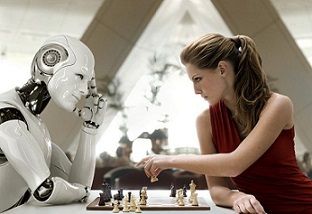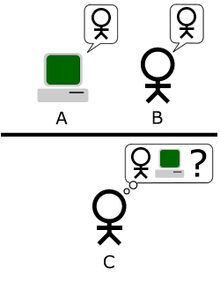Artificial Intelligence Study
Man has called himself Homo sapiens (Wise Man) because our mental abilities are very important to us. For many years we have tried to understand how we think, that is, to understand how a set of matter can understand, analyze, perceive and manipulate a world more complicated than itself. The area of Artificial Intelligence (AI) includes a study that goes much further, since it not only cares to understand but also to create intelligent entities.
Artificial intelligence is a very recent area of computing, everything started shortly after World War II. At present the AI covers a great variety of subfields that go from areas of general purpose like for example the learning and the perception, to others more specific like chess, diagnosis of diseases, demonstration of mathematical theorems, etc.
What is intelligence?
This question is often very controversial because it is very difficult to arrive at an accurate definition of what "intelligence" is. Making an approach we could say that intelligence is the ability to understand, analyze, develop information and use it to solve a problem and can be linked to functions of the mind such as perception and memory.
- Understanding,
- Perception of the environment,
- Self-knowledge
- Reasoning,
- Problem resolution,
- Planning,
- Abstract reasoning,
- Language use and comprehension
- Learning
What is reasoning?
It is defined as the capacity that the human being possesses that allows him to think, evaluate and act depending on a specific situation. It can also be defined as the virtue of using reason or instinct to determine what would be best depending on the situation, what would be the most logical or what is adapted to their needs.
How can we represent knowledge?
Knowledge Engineering: Set of computational techniques to represent structured knowledge (example: databases) and unstructured knowledge (example: images, metadata, rules).
The work of knowledge engineers is to be able to extract knowledge from humans in a specific area, and then encode it so that it can be processed by a system.
What is Artificial Intelligence?
- Systems that think like humans: The new and exciting effort to make computers think ... machines with minds, in the broadest literal sense. (Haugeland, 1985).
- Systems that think rationally: The study of the mental faculties through the use of computational models. (Charniak and Mcdermott, 1985).
- Systems that act as humans: The art of developing machines with the capacity to perform functions that when performed by people require intelligence. (Kurzweil, 1990).
- Systems that act rationally:Computational Intelligence is the study of the design of intelligent agents (Pool et al., 1998).
Throughout history the four mentioned approaches have been followed. There is a clash between human-centered and other approaches centered on rationality.
The human-centered approach should not be an empirical science, including hypotheses and confirmations through experiments. The rational approach involves a combination of mathematics and engineering.

Human behavior: The approach of the Turing test
Turing test, proposed by Alan Turing (1950), was designed to provide an operational and satisfactory definition of intelligence. Turing suggested a test based on the inability to differentiate between indisputable intelligent entities and human beings. The computer passes the test if the human evaluator is not able to distinguish whether the answers to a series of questions raised are from a human being or not. We can say that programming a computer to pass the test requires considerable work. The computer should have these capabilities:
- Processing of natural language that allows you to communicate satisfactorily in English.
- Representation of knowledge to store what you know or feel.
- Automatic reasoning to use stored information to answer questions and draw new conclusions.
- Machine learningto adapt to new circumstances and to detect and extrapolate patterns.
If you want to know more about the Turing Test you can read one of my post about this topic by clicking here
Think like a human: The cognitive model approach
To say that any program thinks like a human, it is necessary to have a mechanism to determine how humans think. There are two ways of doing it, through introspection (trying to catch our own thoughts as they appear) and through psychological experiments. Once you have a sufficiently precise theory about how the mind works, you can express that theory in the form of a computer program.
At the beginning of AI there was confusion in the different approaches: an author could argue that an algorithm solved a task properly and that therefore this would be a good model of human representation, or vice versa. Current authors make differences between the two claims, which has allowed a much faster development of AI and cognitive science. Both fields are added together, especially in the areas of vision and natural language.
Rational Thinking: The "laws of thought" approach
Aristotle was the first to attempt to codify the "correct way of thinking," that is, a process of irrefutable reasoning. Students of logic developed, in the nineteenth century, a precise notation to define sentences on all kinds of elements of the world and specify relationships between them. Already in 1965 there were programs that, in principle, solved any solvable problem described in logical notation. The so-called logistic tradition within the field of artificial intelligence tries to build intelligent systems from these programs.
This approach presents two obstacles. It is not easy to transform informal knowledge and express it in formal terms that require logical notation, particularly when the knowledge you have is less than 100 percent. Second, there is a big difference between being able to solve a problem "in principle" and do it in practice. Although the two previous obstacles are present in any attempt to build systems of computational reasoning, they arose for the first time in the logical tradition.
Act rationally: The rational agent approach
An agent is something that reasons (agent comes from the Latin agere, to do). But IT agents are expected to have other attributes that distinguish them from conventional programs, such as having autonomous controls, perceiving their environment, persisting over a prolonged period of time, adapting to changes, and be able to achieve different objectives. A rational agent is one that acts with the intention of achieving the best result or, when there is uncertainty, the best expected result. In the case of the AI approach according to the "laws of thought", all the emphasis is on making correct inferences. There are also ways of acting rationally that do not involve making inferences. For example, removing the hand from a hot stove is a much more efficient reflex than a slow response carried out after careful deliberation. All the skills needed in the Turing Test must allow rational actions to be taken. It is necessary to be able to generate understandable sentences in natural language, since the statement of such sentences allows agents to function in a complex society. Learning is not carried out exclusively by erudition, but to deepen the knowledge of how the world works facilitates the conception of better strategies to manage it.
Visual perception is necessary not only because seeing is fun, but because it is necessary to have a better idea of what an action can come to represent, for example, seeing a delicious sandwich will help us get closer to it. Studying AI from the design approach of a rational agent offers at least two advantages. The first is more general than the approach provided by the "laws of thought", since making correct inferences is only one of the existing mechanisms to guarantee rationality. The second is more akin to the way in which scientific progress has been made than approaches based on human behavior or thought, because the norm of rationality is clearly defined and of general application. Human behavior adapts well to a specific environment, and it is the product of a complex evolutionary process, largely unknown, that is still far from leading us to perfection. Later it will be clear that in spite of the apparent ease with which a problem can be described, when an attempt is made to solve a huge variety of questions arise.
Subareas of the AI
- Expert Systems (Fuzzy)
- Robotics
- Neural Networks
- Computer vision
- Genetic Algorithms Natural language processing
- Speech Recognition and Synthesis
- Understanding and understanding of text / speech
- Games theory
- Virtual reality
- Artificial life
- Machine learning
- Swarm intelligence
- Distributed AI

Current advances in AI
- Eugene
- Drones
- Autonomous management
- ASIMO
- Simultaneous interpreter
- Personal buyer
- Smart buildings
- Description of texts and images
- Autonomous navigation
- Personalized medicine
- Conversational companions
- IBM Watson
- Google Brain


- Website: https://es.wikibooks.org/wiki/Ingenier%C3%ADa_del_conocimiento/Introducci%C3%B3n
- Website: https://www.psicoactiva.com/blog/diferencia-entre-inteligencia-artificial-e-inteligencia-humana/
- Website: https://www.psicoactiva.com/blog/concepto-inteligencia-ha-evolucionado/
- Website: https://es.wikipedia.org/wiki/Ingenier%C3%ADa_del_conocimiento
- Website: https://es.wikipedia.org/wiki/Inteligencia_artificial
- Book: Artificial Intelligence: A Modern Approach, Second Edition. Stuart J. Russell & Peter Norvig.

